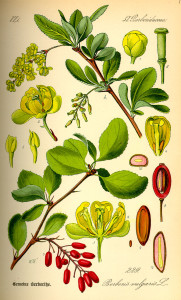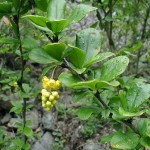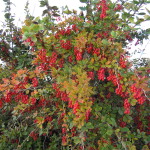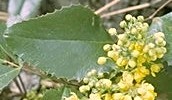Barberry Root- Berberis vulgaris
|
Current Demand = Normal |
Parts Used: Root |
|
|
Family: Berberidaceae
Common Names: barberry, common barberry, berbery, European barberry, jaundice-berry, pipperidge bush, piprage.
Description:
Barberry Root is in the Berberidaceae family. Medicinal uses have long been recorded in history and have been used for liver disorders and diseases along with fighting bacterial infections. The plant is a tall shrub with thorny, grey branches and has bright yellow flowers in late spring. In the fall the branches will sag with red berries. Both the berries and bark are used in healing.
Growing region: Barberry bark is most often found in sandy soil along the coast lines and swamp land areas. It can be seen thru-out the areas from New Jersey and Pennsylvania to the west in Texas and south to Florida.
Harvesting/ Drying
Parts Used: root
Barberry is sold two different ways: root bark and tree bark. Barberry root bark pays approximately four times as much as tree bark. Harvest root bark in the spring or autumn and the tree bark in the fall and early winter months when the sap is moving.
In many areas, Barberry is plentiful and often seen as a nuisance to land owners. When land is being cleared for development or timber these trees are usually pushed over and burned as scrap. Most land owners will and should allow you to collect all the fresh bark available that would otherwise be wasted. When harvesting standing barberry bark, the same rules apply as other trees. Peel only one side of the tree or branch allowing the tree to heal and continue to grow. Pruning branches from smaller bushy bayberry trees also works well for gathering tree bark. This promotes new growth when done in moderation. Do not collect bark from dead or decaying trees as it has no value.
Never mix tree bark with root bark or you will be paid for the cheaper tree bark. The stem-bark is collected by shaving and is dried spread out in trays in the sun, or on shelves in a well-ventilated greenhouse or in an airy attic or loft, warmed either by the sun or by the artificial heat of a stove, leave the door and window open by day to ensure a warm current of air. The bark may be also strung on threads and hung across the room.
Drying time will depend on weather conditions for example; high humidity will slow the drying process as will thicker bark. The more air you can get to each piece of bark, the better it will dry. A thin layer of bark will dry much easier than a pile of bark. When bayberry is dry it will be brittle and snap not bend. After drying is complete, store in paper bags, cardboard or burlap. Never store dried roots, herb or bark in plastic as it will mold.
Planting
Barberries need light for their leaves to turn their vivid colors. Evergreen species can be placed in semi-shade. Best grown in temperate zones. Deciduous barberries are hardy for colder zones than evergreens. All barberries have fine root structures which need a bit of frost protection if grown in shallow pots. Barberry prefers the dry side but should have water at least every two weeks. Using a timed released fertilizer will enhance the growth, but use sparingly, direct application to the tree of fertilizer can kill the tree
When pruning the tree, wait until the flower is in bloom. Pinch back until new growth occurs. Wiring can be used to give support to the limbs/berries. This tree is easily shaped through pruning.
Propagation can be from seed, cuttings taken from softwood at the beginning of summer, or by air-layering. In addition, as the barberry suckers from the roots, it can be propagated by division.
Attributes
“Berberis vulgaris ” by Arnstein Rønning – Own work. Licensed under CC BY-SA 3.0 via Wikimedia Commons.
“Berberis-vulgaris-flowers” by Sten. Licensed under CC BY-SA 3.0 via Wikimedia Commons.
“Berberis vulgaris3” by J.F. Gaffard – J.F. Gaffard. Licensed under CC BY-SA 3.0 via Wikimedia Commons
Drawing Public Domain
 Root Buyer
Root Buyer



